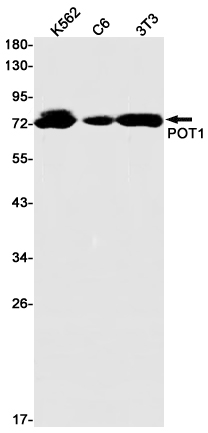
| WB | 1/500-1/1000 | Human,Mouse,Rat |
| IF | 咨询技术 | Human,Mouse,Rat |
| IHC | 咨询技术 | Human,Mouse,Rat |
| ICC | 技术咨询 | Human,Mouse,Rat |
| FCM | 咨询技术 | Human,Mouse,Rat |
| Elisa | 咨询技术 | Human,Mouse,Rat |
| Aliases | POT1; Protection of telomeres protein 1; hPot1; POT1-like telomere end-binding protein |
| Entrez GeneID | 25913 |
| WB Predicted band size | Calculated MW: 71 kDa; Observed MW: 71 kDa |
| Host/Isotype | Rabbit IgG |
| Antibody Type | Primary antibody |
| Storage | Store at 4°C short term. Aliquot and store at -20°C long term. Avoid freeze/thaw cycles. |
| Species Reactivity | Human,Mouse,Rat |
| Immunogen | A synthetic peptide of human POT1 |
| Formulation | Purified antibody in TBS with 0.05% sodium azide,0.05%BSA and 50% glycerol. |
+ +
以下是3-4条关于POT1抗体的参考文献及其摘要内容的简要概括:
1. **文献名称**: "Protection of telomeres through independent control of ATM and ATR by TRF2 and POT1"
**作者**: Denchi, E.L., & de Lange, T.
**摘要**: 该研究利用POT1抗体进行免疫沉淀和功能实验,揭示了POT1与TRF2协同调控端粒对ATM/ATR信号通路的抑制作用,维持端粒稳定性。
2. **文献名称**: "Mutations in POT1 predispose to familial cutaneous malignant melanoma"
**作者**: Robles-Espinoza, C.D., et al.
**摘要**: 通过POT1抗体的免疫组化分析,发现家族性黑色素瘤患者中POT1突变导致端粒异常延长和染色体不稳定,揭示了POT1在癌症遗传易感性中的作用。
3. **文献名称**: "Telomere protection by mammalian Pot1 requires interaction with Tpp1"
**作者**: Hockemeyer, D., et al.
**摘要**: 使用POT1抗体的免疫荧光和共聚焦显微镜技术,证明POT1依赖Tpp1结合定位于端粒,并阐明其在端粒末端保护中的分子机制。
4. **文献名称**: "POT1 disruption in PHF8-deficient cells promotes tumorigenesis via telomere dysfunction"
**作者**: Wang, Y., et al.
**摘要**: 通过Western blot和ChIP实验(使用POT1抗体),发现组蛋白去甲基化酶PHF8缺失导致POT1表达下调,从而引发端粒损伤和肿瘤发生。
以上文献均涉及POT1抗体的实验应用(如免疫沉淀、染色、Western blot等),聚焦于端粒保护机制、癌症关联及分子相互作用研究。
The POT1 (Protection of Telomeres 1) antibody is a critical tool for studying the role of the POT1 protein in telomere maintenance and genomic stability. POT1. a component of the shelterin complex, binds single-stranded telomeric DNA through its oligonucleotide/oligosaccharide-binding (OB) folds, forming a protective cap at chromosome ends. It collaborates with TERC (telomere repeat-containing RNA) and other shelterin proteins to prevent telomere degradation, fusion, or recognition as DNA damage sites. Dysregulation of POT1 is linked to telomere shortening, premature aging, and cancer.
Mutations in *POT1* are associated with familial melanoma, gliomas, and chronic lymphocytic leukemia (CLL), making it a biomarker for cancer research. POT1 antibodies enable detection of POT1 expression levels, localization, and interactions in cells, aiding studies on telomere biology and disease mechanisms. They are used in techniques like Western blotting, immunofluorescence, and immunoprecipitation to explore POT1’s role in suppressing DNA damage responses (e.g., ATM/ATR activation) and regulating telomerase activity.
Commercial POT1 antibodies are typically raised in rabbits or mice, validated for specificity against human POT1 isoforms. Researchers rely on these antibodies to investigate therapeutic strategies targeting telomere-related disorders and malignancies. Understanding POT1’s function through antibody-based assays contributes to insights into aging, cancer progression, and potential drug development.
×